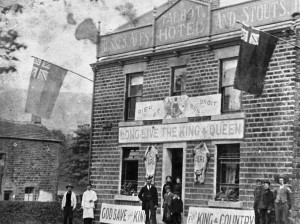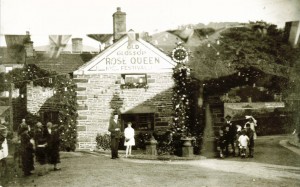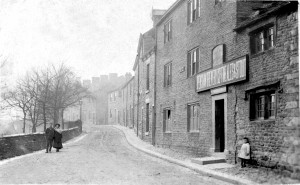One of the highlights of the year across the region was the ‘Wakes’, or ‘Wild Weekend’ as it became known.
The Wakes, originates from a festival of the village church, and is derived from an Anglo-Saxon word relating to the late hour of the vigils or eves that began the religious festivals. People were ordered to respect the religious festivals and it was observed that following the church services the people “fell to lewdness and songs, dances, harping, piping and also to gluttony and sin and so turned holiness to cursedness”
The Wild Weekend in Old Glossop was very well celebrated and enjoyed. It maintained its link to all the things prohibited and became a much-anticipated event. Allegedly quarrels and feuds were saved up for the Wakes, participants stripped to the waist and the battle moved down the hill from ‘the Bull’ knocking over stalls and spilling and breaking goods.
Glossop’s regular market swelled during the wakes with stalls and side-shows. It is said that by about 1820 an old lady from Yorkshire first brought roundabouts to the town Wakes. They were crudely shaped hobby-horses with sticks for legs, a flat board for a back and head that wasn’t exactly horse-like. The roundabout was rotated by local boys who would push it round for the fun of it and also get a free ride once it was going fast enough in spite of the efforts of the old lady to drive them off with a long whip.
The festivities stretched along Church Street from The Talbot, past the Old Cross and up to The Bulls Head
Listen to Janet Connor (born 1893) talking about her memories of the Wakes. The interview was recorded in the 1970s by her grandson, Tony Wright, using an old four track recorder.
“The fair, coconut stalls, everything. Round the old cross would be the roundabout and things like that. The stalls were all down, in Old Glossop. And in those days every house was what they call ‘open house’ and anybody could walk in and have a cup of tea. It was really wonderful, it was. Really wonderful!”
Another important tradition was ‘The Rush Cart’. A farm cart or wagon and a team of well turned out horses was borrowed. A pyramid of rushes was built up in the centre of the cart and wreaths or garlands were then attached to the pyramid. In later years a variety of shiny objects, such as copper kettles and silvery tea-pots, along with flowers, gaily coloured ribbons and sparkling trinkets were used in the garlands.
Once decorated the Rush Cart took its place in a procession round the village. Three characters led the procession: one finely dressed carrying a pole bearing an item symbolic of the pursuits of the inhabitants – originally a farmers smock – and later an item representing the cotton industry; a sweep making faces at the crowds; and then the village idiot wearing red plush breeches a horses collar and an asses head.
Bands and the Morris dancers followed on behind and after the parade the Rush Cart returned to the parish church where the rushes were taken inside and strew on the floor –the original purpose of the rush gathering – for use as a carpet for the stone church floors.



